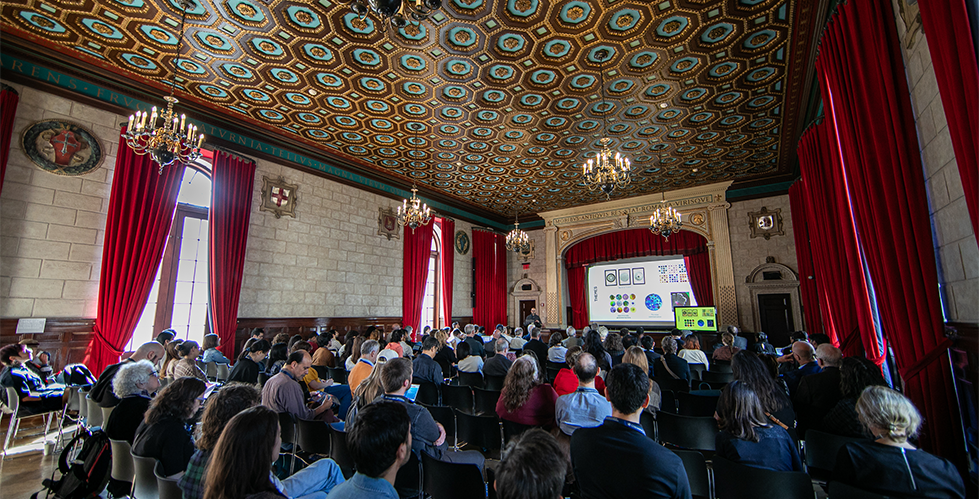Exploring the Intersection of Art and Science: Visualizing Science Symposium Inspires and Illuminates
The Visualizing Science Symposium: The Impact of Art on Scientific Discovery, hosted by Columbia Creative and the Herbert and Florence Irving Institute for Cancer Dynamics (IICD), brought together a vibrant mix of scientists, artists, and enthusiasts for a day dedicated to exploring how artistic perspectives can deepen our understanding of science. Held at the Italian Academy at Columbia University, this event was a remarkable success, offering attendees the opportunity to engage in thought-provoking discussions, witness stunning visual representations of scientific research, and be inspired by the potential of interdisciplinary collaboration. This symposium was made possible through the generous support of our sponsors: Herbert Irving Comprehensive Cancer Center, Irving Institute for Cancer Dynamics, Columbia's Italian Academy for Advanced Studies, Columbia University Data Science Institute, and Columbia Zuckerman Institute.
"Visualizing science is a powerful way to bring complex ideas to life, transforming abstract concepts into sensory experiences that resonate beyond text," shared Nicoletta Barolini, Art Director and Science Visualizer in the Office of Public Affairs at Columbia University. "This event showcased the incredible creativity that emerges when we embrace multiple senses to communicate science, reminding us that true understanding deepens when we engage with the world in diverse ways. It was inspiring to witness how art and science can unite to foster a more intuitive and impactful connection to knowledge."
The symposium’s agenda was thoughtfully curated to encompass diverse perspectives. The morning sessions included insightful presentations from distinguished speakers like Stephon Alexander, Professor of Physics at Brown University, presenting The Jazz of Physics, and Tal Danino, Associate Professor of Biomedical Engineering at Columbia University, captivating the audience with mesmerizing images of the micro-universe where bacteria become art. Carolina Rojas, part-time faculty and doctoral candidate at Teachers College, Columbia University, explored the connections between art, natural sciences, and preservation. Medical historian Richard Barnett guided attendees through the evolution of medical illustration. Anatomical illustrator Roberto Osti revealed the hidden narratives within precise scientific imagery, and Jill Gregory, a medical illustrator at the Icahn School of Medicine, highlighted the growing role of inclusivity and technology in visual communication in medicine.
The afternoon continued to push creative boundaries with Owen Harris from Súil Vision discussing Game Design for Science, and Beata Mierzwa, a science artist from UC San Diego, using visual metaphors to illuminate scientific concepts. Harvard's Kit Parker, Professor of Bioengineering and Applied Physics, shared insights on how transforming laboratories into creative studios can spark breakthroughs in bioengineering. The day concluded with a panel discussion on the future of art, science, and AI, moderated by Steven Feiner and featuring experts Lydia Chilton, Gaël McGill, Vishal Mishra, Vikash Sehwag, and Jeannette Wing.
Attendees left the symposium inspired, with many expressing how the event broadened their perspective on science communication and sparked ideas for their own research and creative projects.
"I am thrilled by the success of our Visualizing Science Symposium: The Impact of Art on Scientific Discovery event. Bringing together researchers, artists, and science communicators to explore the powerful intersection of art and science has not only inspired new perspectives but also underscored the importance of creativity in advancing scientific understanding. Witnessing the enthusiasm and engagement from our community was truly rewarding, and I look forward to building on this momentum to foster even more innovative approaches to cancer research,” said Simon Tavaré, Professor of Statistics and Biological Sciences, and Director of the Irving Institute for Cancer Dynamics.
The symposium highlights the value of interdisciplinary partnerships, showing how the integration of visual art into scientific fields can catalyze both understanding and innovation. The success of this year's event promises a growing focus on the artistic impact within scientific research, and we eagerly anticipate more collaborations and discussions in the years to come.
View the full photo gallery here. Photo credit: Tim Lee.

